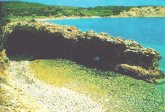|
LIPSOI
Leipsi or Leipso or Leipsai followed the course of history of the other
Dodecanese Islands. It was inhabited by Kares in the 14th century B.C.,
followed by the Dorians in 1200 B.C. and later, by Ions who probably
came from Militos in Asia Minor, a colony of Attica. Pots and potsherds
were found from the Mycenean (1600-1100 B.C.) and the Geometric periods
(1100-800 B.C.). The marble Ionian capital which was found in the area
of Saint John and dates from the 4th century B.C., the oil lamps of
the first Hellenistic period (3rd century B.C.) and the tombs and marble
inscribed columns confirm the continuously developing habitation, whose
center was the fortified tower of the Castle, which dominates the whole
area. Archaeological finds are built into the wall of churches and homes.
Remains of houses exist even from pre-Christian times. The foundations
of a big temple have been found at the Church of the Virgin Mary of
Kousselio. It seems that an ancient temple lay on the same spot. We
do not have any historical data until 730 A.D., when the islands of
Lipsi, which were by then part of the Byzantine Empire, acquired strategic
importance. But the islands were devastated by the conflicts between
the Byzantines and the Arabs, especially the invasions of the latter.
In the 11th century (1088), this island, together with the island of
Patmos, was transferred to Ossios Christodoulos by the Golden Bull of
Alexios Komninos the First. The island remained in the possession of
the Monastery of Patmos for 556 years, during which time it exploited
its land for farming and grazing. During this period, many monasteries
and hermitages were founded, such as the Kimissi at Romani in the West
(1500), Kato Panagia, in the West (Church of the Annunciation, 1770),
Panagia of Haros (1600).
In 1522, the island yielded to the Turks who limited themselves to collecting
taxes, making predatory raids, grabbing animals and killing monks but
avoided inhabitation. The populated area one can see today was founded
in 1669 by a person from Crete named Lios (Elias) when Crete passed
from the Venetian to Turkish Occupation. During this period, many people
abandoned the island and were spread throughout the Dodecanese and other
islands. Lios used a cave above the Lendou area for his first home and
later on, built his house, the first one on the hill, where the post
office is today. During the Greek Revolution of 1821, Lipsi played an
important part in the War of Independence offering shelter to the rebels
and helping them prepare for war. They also helped Theophilos Pankostas
from the island of Patmos, Patriarch of Alexandria and many captains
from the islands of Hydra, Spetses and Psara. Two letters of great historical
significance have been found: they were written by Andreas Miaoulis
in Leipsi on August 21st and 23rd, 1824, full of enthusiasm and rage
against the enemy, thus motivating and encouraging the Admiral of Psara
who was in Patmos with his fleet. Miaoulis left Leipsi and many Greeks
left other locations united against the Turks for the big naval battle
of Gerontas, on the coast of Asia Minor, where the Turkish and Egyptian
Fleets were forced to retreat on August 29, 1824.
For a few years, Leipsi managed to maintain its independence, but the
Settlement of Constantinople, in July 9, 1932, left the Dodecanese as
well as many other regions, outside the boundaries of Greece. The Turkish
presence became more noticeable when a six-man guard belonging to the
Administration of Leros island, came to the island. The islanders however,
continued to vote for their own elders because the Turks did not know
the language. Voting was held in the open. Voters used to gather in
the main square, the candidates stood in the corners and lifted their
walking canes. This was a signal for the voters to go to the candidate
of their choice.
During the First Balkan War, in 1912, Italian troops liberated the Dodecanese
Islands. But the islanders soon discovered that the new conquerors expected
greater obedience than before. Starting with the schools, the Italians
imposed their own language and religion. In March, 1948, the island
was united with Greece after the defeat of Italy in the Second World
War. After the ravage of Asia Minor, in 1922, and the uprooting of the
Greek population, many refugees settled in Leipsi.
The only populated region of Leipsi is situated on the hill where Lios
from Crete built his first home. It extends towards the safe harbour.
At the top, next to the square where lies the Museum and the Town Hall,
one can see the magnificent white Church of Saint John Theologos, with
its blue dome and two bell-towers. The houses are painted white with
a blue outline around the doors and windows. This habit dates from the
Italian occupation, when the islanders used to paint their homes with
the colours of the Greek flag. The school is another nice building,
built by the hard work of the islanders and their immigrant children.
The people live off of fishing, cattle-breeding and agriculture. The
region is well known for its wine. In the past, the production reached
300 tons and during the Italian occupation, it was sent to the Vatican
for Holy Communion. Today, the Municipality, in collaboration with the
Athens School of Agronomy, is trying to replant the area with plants
more resistant to dry climates. In the summer, many people visit Leipsi
for its clean beaches, fresh fish, calm landscape and hospitality
by Stefanos Stefanidis
Copyright: Hellenic Electronic Center
Back to the Dodecanese Islands
|
 |
